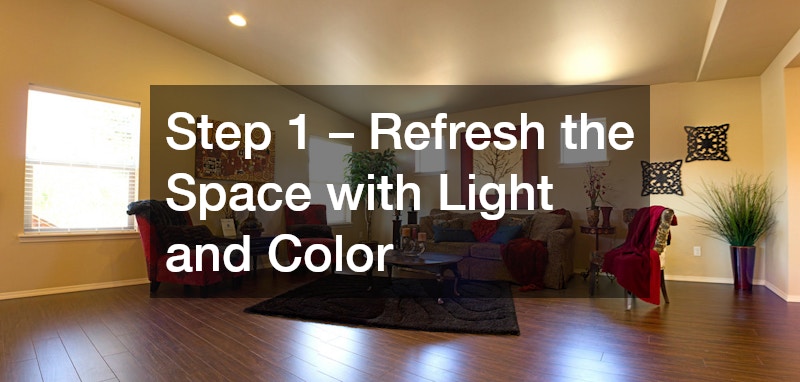Older homes have a magic that new construction simply can’t replicate. From the craftsmanship of hand-carved moldings to the character of aged hardwood floors, these spaces hold history and heart. Yet, as lovely as they are, time eventually takes its toll. Paint fades, pipes corrode, and energy systems struggle to keep up with modern demands. That’s when homeowners start thinking about how to make their homes feel vibrant again without losing that original charm.
Bringing new life to an older home isn’t about erasing its history — it’s about embracing it while incorporating modern comforts. With today’s technology, materials, and design trends, even the oldest house can feel fresh, efficient, and welcoming. Whether you’re restoring a century-old farmhouse or updating a 1970s split-level, focusing on the best new home upgrades helps you retain the soul of your home while adding the functionality and beauty of modern living.
In this guide, we’ll explore the most effective ways to make older homes feel new again — from refreshing interiors and improving energy efficiency to upgrading exteriors and embracing smart design choices that blend the past and present seamlessly.

Step 1 – Refresh the Space with Light and Color
One of the easiest and most transformative ways to make an old home feel new again is by brightening it up. Natural light and fresh colors instantly lift the mood of any space, especially those that have grown dim over the years.
Start with the walls. A simple coat of paint can make a dramatic difference, turning dull or dated rooms into cheerful, open spaces. Soft whites, warm beiges, and light grays are timeless and make smaller rooms appear larger. If your walls are textured or damaged, smoothing them before painting can bring a professional, polished look.
Lighting also plays a key role. Replacing old fixtures with energy-efficient LED options is one of the best new home upgrades you can make. Layer your lighting: combine ceiling lights with table lamps, under-cabinet strips, and sconces for a balanced effect. Use warm lighting tones to create a cozy yet contemporary atmosphere.
Don’t underestimate the power of reflective surfaces either. Adding mirrors, glass decor, or glossy finishes to furniture and trim bounces light around the room, making everything look brighter and more modern. Even small updates, like swapping outdated curtains for sheer panels, can breathe new life into older spaces.
Step 2 – Modernize Key Rooms for Function and Flow
The kitchen and bathroom are two of the most used spaces in any home — and they’re often the most outdated in older houses. Fortunately, these rooms also offer the biggest return when refreshed thoughtfully.
Kitchen Updates That Transform the Heart of the Home
The kitchen is where families gather, meals are shared, and memories are made. Updating it doesn’t require a full remodel. You can make impactful changes by refinishing cabinets, upgrading hardware, and choosing a sleek new backsplash. Pair these with modern appliances to increase both functionality and efficiency.
Installing new countertops instantly changes the look of the entire space. A professional countertop installation gives you the opportunity to choose from durable materials like quartz, granite, or recycled glass — each adding elegance and ease of maintenance. Combined with new lighting and a fresh coat of paint, your kitchen can look brand new without major construction.
For plumbing fixtures, choose finishes that complement your design style — matte black, brushed nickel, or polished chrome are all timeless. If the plumbing is old or inefficient, hire a reliable plumbing company to replace outdated pipes and ensure water efficiency.
Bathroom Refreshes for Comfort and Style
Bathrooms tend to show their age through tile grout, outdated vanities, and poor ventilation. Start by replacing old fixtures with water-saving models that reduce waste and improve performance. Installing modern tile or waterproof vinyl flooring adds visual appeal while preventing moisture damage.
For a spa-like feel, consider one of the best new home upgrades: adding radiant floor heating or a rainfall showerhead. Updated lighting, mirrors, and paint can make even a small bathroom feel larger and more luxurious.

Step 3 – Improve Energy Efficiency and Comfort
Older homes weren’t built with modern energy standards in mind. Drafty windows, insufficient insulation, and aging systems can make them uncomfortable and costly to maintain. Addressing these issues is not only one of the best new home upgrades, but it also increases property value and sustainability.
Start by inspecting insulation and sealing air leaks around windows and doors. Partnering with a waterproofing company can help address hidden leaks or foundation cracks that lead to heat loss or moisture buildup.
If your heating system struggles to keep up, consider upgrading with assistance from home heating oil companies or converting to a high-efficiency furnace. For cooling, a local HVAC service can replace outdated units with modern systems that provide consistent temperature control and lower energy bills.
Installing double-pane windows, smart thermostats, and energy-efficient lighting are simple yet powerful changes. Combine these with other best new home upgrades, such as solar panels or ceiling fans with built-in air purifiers, for comfort that feels clean and contemporary.
These energy-saving measures not only improve quality of life but also reduce your environmental footprint — a win for your family and the planet.
Step 4 – Restore the Details That Make It Special
While modernization is key, the most beautiful renovations respect a home’s original character. Those little architectural touches — the crown molding, arched doorways, and wooden beams — give your home its soul. Instead of covering them up, restore and highlight them.
Sanding and refinishing hardwood floors is one of the best new home upgrades for preserving authenticity. Instead of replacing old wood, restore it to its natural shine with eco-friendly stains and sealants. Similarly, if you have built-in bookshelves, wainscoting, or vintage light fixtures, keep them — just update the finishes or rewire them for safety.
Fireplaces are another focal point worth saving. Clean them thoroughly and upgrade their mantels for a striking modern contrast. If your chimney hasn’t been serviced in a while, hire a professional to inspect and clean it. This simple maintenance ensures safe, efficient use and keeps one of your home’s coziest features in working order.
By honoring your home’s original craftsmanship while adding subtle modern touches, you’ll create a design that feels both fresh and timeless.

Step 5 – Upgrade Exterior Elements for Curb Appeal
The outside of your home is the first thing people notice, and updating it can instantly make your property feel new again. Even small exterior changes can dramatically improve curb appeal and pride of ownership.
Start with the roof — an area often overlooked until there’s a problem. Working with a trusted metal roofing company can improve both the look and durability of your home. Metal roofs are long-lasting, energy-efficient, and resistant to weather damage, making them one of the best new home upgrades for older houses.
Next, focus on your driveway and walkways. Cracked or uneven pavement can make a home look neglected. A local paving company can restore smooth, durable surfaces that complement your landscaping. Add low-voltage lighting along walkways for nighttime visibility and charm.
If you live in a rural area, land clearing services can help open up overgrown spaces, improve drainage, and create room for new outdoor features like patios or gardens. Pair that with new fencing, porch railings, or a fresh coat of exterior paint for a polished finish.
Don’t forget functionality. If your garage door is old or unreliable, scheduling professional garage door repair not only improves appearance but also enhances safety and convenience.
These exterior transformations instantly boost property value and make your home as welcoming on the outside as it is within.
Step 6 – Redesign Layouts for Modern Living
Many older homes were built with smaller, compartmentalized rooms. While cozy, these layouts often don’t fit today’s lifestyles. Opening up your floor plan or repurposing underused areas can make your home feel larger and more functional.
Removing non-load-bearing walls is one of the best new home upgrades for improving flow. It connects the kitchen, dining, and living areas, creating open spaces where families can gather more naturally. For a compromise between open and private, add archways or sliding doors instead of full walls.
Convert unused spaces — like attics, basements, or formal dining rooms — into practical areas. A basement can become a family entertainment zone, while a finished attic might serve as a guest suite or office. If your property has extra land, plan an addition with help from professionals who understand your home’s structure and zoning requirements.
Don’t overlook the power of furniture placement either. Sometimes simply rearranging pieces can change how a room feels. Use area rugs and lighting to define spaces in open layouts and preserve intimacy.

Step 7 – Address Hidden Issues Before Cosmetic Fixes
Before diving into design updates, take time to inspect what’s behind the walls. Cosmetic changes won’t mean much if your home has underlying issues like leaks, poor drainage, or outdated wiring.
Start with plumbing and electrical systems. Hiring a plumbing company to assess old pipes or fixtures ensures safety and prevents future water damage. Upgrading to modern materials improves both water pressure and quality.
Older foundations may develop cracks or damp spots over time. A waterproofing company can identify vulnerabilities and seal them before they cause mold or structural damage. If your home relies on a septic system, regular septic tank maintenance is vital to prevent backups or contamination.
Check your attic, crawl spaces, and basement for pests, insulation damage, or signs of leaks. Tackling these hidden problems first is one of the best new home upgrades because it protects every improvement you make afterward.
Once these issues are handled, you’ll have a solid foundation for the creative updates that follow — literally and figuratively.
Step 8 – Add Smart Technology for Modern Living
Technology has become an integral part of comfortable, efficient homes. Integrating smart features is one of the best new home upgrades you can invest in, and it doesn’t have to disrupt your home’s classic charm.
Start small with smart thermostats and lighting systems that adjust automatically based on occupancy or time of day. These devices save energy and enhance convenience. Add smart plugs for voice-activated control of lamps, TVs, and appliances.
Security technology has also advanced dramatically. Install smart locks, motion sensors, or camera doorbells to keep your family safe. These features can easily blend with traditional aesthetics, offering peace of mind without visual clutter.
Consider a central hub or app to control your systems. Many homeowners use their smartphones to monitor temperature, lighting, and even garage doors from anywhere. When combined with good insulation and reliable energy sources, these tech upgrades make your home both intelligent and inviting.
Step 9 – Reimagine Outdoor Living Spaces
Outdoor areas are extensions of your home, and upgrading them enhances both lifestyle and value. Whether you have a small backyard or acres of land, thoughtful design can turn any outdoor space into a retreat.
Start by repairing or expanding patios and decks. Comfortable seating, soft lighting, and weather-resistant furniture can transform an overlooked space into a cozy gathering area. Add features like fire pits or outdoor kitchens to make the area functional year-round.
Landscaping is another of the best new home upgrades for creating a polished look. Choose native plants for easy maintenance and sustainability. Strategic planting can also provide shade, privacy, and noise reduction.
If drainage is an issue, consult professionals to regrade surfaces or install proper systems. Pair landscaping improvements with outdoor lighting to highlight pathways and trees. Even minor touches — like hanging plants or updating exterior hardware — contribute to a fresh, cohesive feel.
Outdoor spaces should reflect your home’s personality while offering a calm escape from the daily routine.
Step 10 – Personalize with Decor and Texture
Once the structural and functional work is complete, it’s time to focus on the finishing touches that make a home truly yours. Decor brings warmth, color, and life back into a space.
Mix old and new styles to honor your home’s history while keeping it contemporary. For instance, pair antique furniture with modern artwork or minimalist lighting. Introduce texture through fabrics — soft throws, woven rugs, and linen curtains make rooms feel inviting.
Display personal touches such as family photos, heirlooms, and travel souvenirs. These elements tell your story and remind you of your home’s journey. Choose cohesive color palettes that reflect your personality while maintaining flow from room to room.
Adding natural elements — like wood, stone, or plants — enhances tranquility. The combination of old charm and modern simplicity creates balance and timeless appeal.
Ultimately, the finishing phase is where functionality meets beauty. It’s the emotional part of transformation — the stage where your home feels whole again.
Making an older home feel new again is a journey of care, creativity, and craftsmanship. It’s about preserving character while introducing fresh design and efficiency. By focusing on the best new home upgrades, you can improve comfort, safety, and aesthetics without losing what makes your house unique.
Whether you’re restoring vintage floors, replacing outdated systems, or expanding outdoor spaces, every decision contributes to a renewed sense of pride and warmth. A trusted team — from local HVAC service experts to metal roofing company professionals — can help guide the process safely and effectively.
In the end, the goal isn’t to erase history but to give it a new chapter. Your home’s age tells a story — one that continues to grow with every coat of paint, repaired fixture, and upgraded detail. By investing in thoughtful improvements today, you’ll create a space that feels both timeless and new for generations to come.



